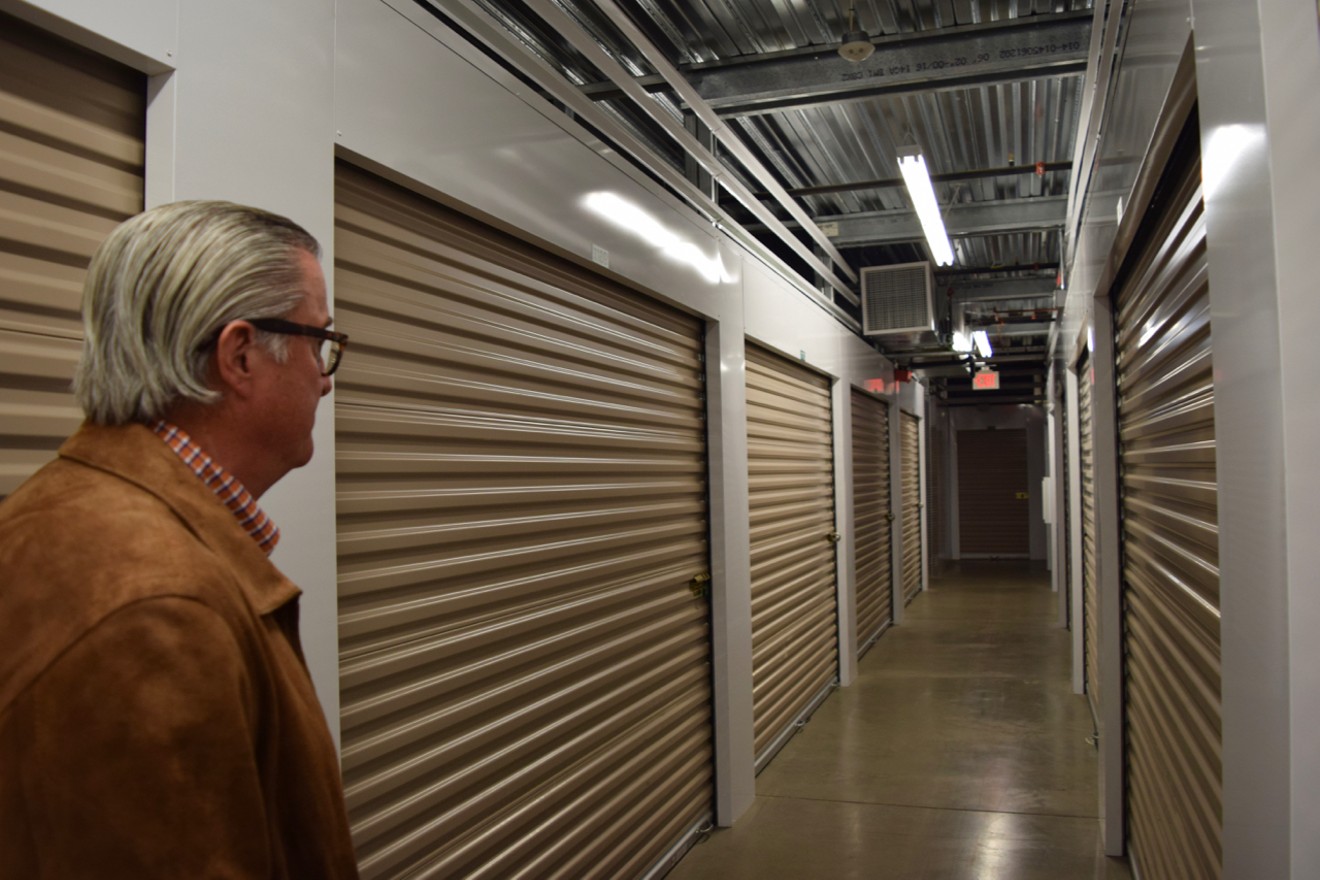Knowing her way through a self-storage maze is part of the job. As the general manager of this CubeSmart Self-Storage location, Giordano is the guardian of the worldly possessions kept in the climate-controlled, two-story warehouse on Jefferson Street in downtown Phoenix. She oversees almost 1,000 units. Walking past door after door in the warehouse, nothing to mark your way forward or back, you feel slightly unmoored. Top 40 pop was being piped in from unseen speakers, but otherwise the facility was quiet, clinical, and nearly empty.
In a vacant unit with several lines of red tape on the floor, Giordano explained the available storage sizes. She helpfully pointed out how space much a 5-feet-by-5-feet or 5-by-10 unit affords the tenant. “This way, you can envision your belongings inside the space, without looking at a picture or trying to guess,” Giordano said.
At her location, about half of the units are currently occupied, Giordano said. CubeSmart’s customers include lots of college students, businesses storing extra inventory, and a few people experiencing homelessness. But once the door slams shut, it’s impossible to know the faceless person behind each unit.
“Self-storage is an event business,” Giordano said. “There’s always something happening in someone’s life that makes them need storage.”
Judging by last year’s growth figures, she might be right.
2017 was a banner year for self-storage in Phoenix. Twenty-five new locations opened in the metro area last year, according to a report by Paul Boyle, an executive director at real estate firm Cushman and Wakefield. Southeast Valley cities like Gilbert and Chandler saw the most new construction, with 10 self-storage centers, followed by five new centers in Phoenix.
Last year’s construction added more than 3,300 units to greater Phoenix. It adds up to 2.4 million square feet of storage — the most of any metro area after Dallas, according to the firm. Boyle can’t think of a time in the last decade when the Phoenix market saw more self-storage construction.
Even crazier is that at the end of the year, 18 new metro Phoenix locations were under construction and 51 were in the planning phase.
These aren’t necessarily your grim storage facilities with garage-like units, padlocked but otherwise exposed to the elements in some godforsaken concrete lot. Many of the new storage centers here are different.
They’re indoors and climate-controlled. Some have large windows carefully positioned to face the road; glance in and you can see the facility's spotless interior. Some centers have cheerful yellow or red doors on their units. Companies have reassuring names like Life Storage, StorQuest, and CubeSmart (slogan: “It’s what’s inside that counts”).
The branding strategy is clear: Our self-storage facility is secure and clean, a good home to offload whatever is gathering dust. You can trust us with your prized possessions and family heirlooms — or your junk.
But why the boom?
“The reason why self-storage is a recession-resistant market is because people need self-storage when things are good and bad,” said Anne Mari DeCoster, the executive director of the Arizona Self-Storage Association. “When things are bad, they need it because they’re moving in with their parents. When things are good, they’re using it because they’re moving into a new house.”
Factor in the steady population growth of Maricopa County, and there’s evidently enough demand to encourage self-storage construction here. Businesses use about 20 percent of the typical storage facility’s units, but the vast majority of tenants are individuals and families in a period of transition, DeCoster said.“Either they’re getting married, or getting divorced. They’re having children, or their children are moving away. Or they’re moving away, or they’re moving here.”
tweet this
“Either they’re getting married, or getting divorced. They’re having children, or their children are moving away. Or they’re moving away, or they’re moving here,” DeCoster said.
When people encounter a life event that requires storage space, she added, that increases the likelihood that they’ll turn to self-storage again down the road.
Pent-up demand in the fast-growing Phoenix metro area encourages new storage development. But the self-storage business can be a lucrative one, no matter where the facilities are located.
The mechanics of making money in self-storage are incredibly simple: Build a facility, attract enough renters to cover your costs, and watch the revenue flow in. Low overhead, minimal upkeep.
“It’s like if you compare, for instance, to restaurants — how frequently they open and go out of business,” DeCoster said. “You don’t see that happening in self-storage. The fundamentals of this market are much simpler and more solid.”
Once you reach the break-even point, DeCoster explained, every additional unit goes straight to the storage center’s bottom line.
National brands have apparently figured this out.
Large self-storage chains operate as real estate investment trusts, or REITs. These companies often will buy independently owned storage centers once the local operator has built a facility and obtained the required permits. CubeSmart and Life Storage are among the largest self-storage REITs. Both are publicly traded companies that operate more than 700 self-storage facilities across the U.S.
On the upper level of the CubeSmart facility on Jefferson Street, Giordano said their location opened in November 2017, replacing a furniture store. She passed by a man at his storage unit who was rearranging his golf equipment, surrounded by a pile of cardboard boxes. After working for CubeSmart in Phoenix for seven years, Giordano has gotten to know familiar faces who stop in to check on their items.
She said, “It’s kind of like apartments, but they don’t live here.”
Not all of the self-storage facilities sport a national brand-name. Garfield Storage is independently run. Owner Mark McLoone, a managing partner at Hibernia Capital Advisors, gave a tour of the facility recently and explained how his properties are not like the cookie-cutter chains.
“At the end of the day, the folks in your neighborhood are your customers,” McLoone said. “And the last thing you want to do is build some monstrosity and have them drive by it everyday shaking their fist.”
Unlike the larger facilities, McLoone has no set formula for his storage centers, which he's built in Southern California and Phoenix. This facility’s brick design was intended to help Garfield Storage fit into the neighborhood without looking like an eyesore. Community members liked the antique warehouse look, he said.
Garfield Storage opened just over a year ago on the corner of North 16th Street and Portland Street. McLoone’s associate David French, another Hibernia employee, said that they tried to realistically evaluate how much demand there was in the neighborhood, as opposed to the big-box storage centers sprouting up practically right next to one another.
“Unless a whole lot of people move to some of these areas where they’ve built a bunch of these facilities, they’re just not going to fill up, unfortunately,” French said.

Before constructing the facility, Garfield Storage's management consulted with the neighborhood to avoid looking like a self-storage "monstrosity."
Joseph Flaherty
McLoone understands that the self-storage business could change with trends because a new generation is growing up with different tastes and hangs onto less stuff. But ultimately his wager is that people like to hoard.
“At the end of the day, we’re a consumer society," McLoone said. "And people like to have stuff, and they seem to like to hang onto it."
Not everyone is thrilled with the crush of new facilities. If you’re a small business or an apartment-dweller, do you want a self-storage place next door? In the life of the neighborhood, aren’t there better options than a staid warehouse? What about a restaurant? Better yet, a grocery store? Or even another apartment building?
McLoone agrees with the industry view – all told, there are worse neighbors than a self-storage facility. “Not everybody loves storage, but it doesn’t generate very much traffic. It’s quiet. You don’t have the frat party at 2 a.m. at the apartment building,” McLoone said.
As far as the national competitors go, DeCoster said she doesn’t expect national storage chains like U-Haul and Extra Space to buy up many more of the existing facilities here.
“We’re reaching a point where a lot of new stores have opened,” she said. “And that changes the pro forma for any additional store that’s going to be bought because new stores are additional competition, so they don’t expect the new stores to lease up as quickly.”
Perhaps we should have expected a self-storage boom. To state the obvious, we live in a country that’s split between a sliver of people at the top enriching themselves while other people struggle to get by.
Squeezed by rising housing costs and an insecure gig economy, self-storage can be helpful if you’re bouncing around in search of a new job, or crammed into a too-small apartment that already eats up too much of your paycheck. At CubeSmart and Garfield Storage in Phoenix, some renters are experiencing homelessness and need a place to store their possessions while they get back on their feet. (“As long as they’re good customers and follow the rules, we’re not going to turn anybody away,” Giordano said.)
And then there’s the other end of the inequality spectrum. You need self-storage if there’s no room at home for your bulky ski gear or the expensive Christmas decorations you take out once a year. A glut of self-storage is a very American solution for a fundamental American problem.
“The ones who are doing well are storing their boats,” DeCoster said. “The ones who are not doing well are storing their furniture because they moved in with Mom.”
And in the Valley, where it seems like everyone is a transplant who moved here within the last two years, self-storage is useful for people on the move.
At CubeSmart on Jefferson Street, 38-year-old artist Tony Lemos was storing a few canvasses in Phoenix before leaving for Colorado to work on an organic farm. “I’ll be out there for the next year,” he said as he carefully moved a painting of a white egret from a U-Haul to a dolly. “We’ll see what happens after that.”
Yet Lemos is still tied to Phoenix. His family is here. And now his art is too, tucked away beyond an unmarked door, just another unit in the maze.














